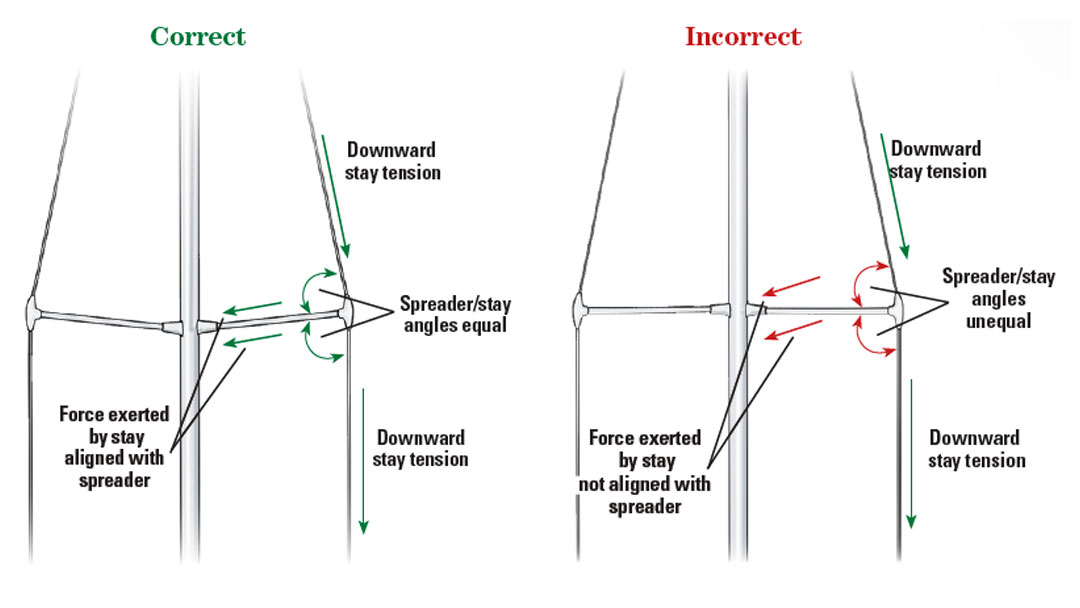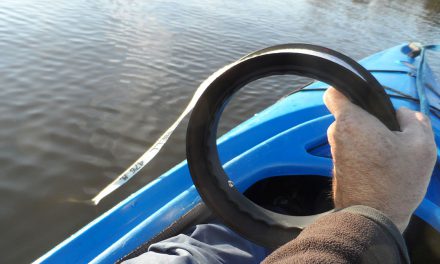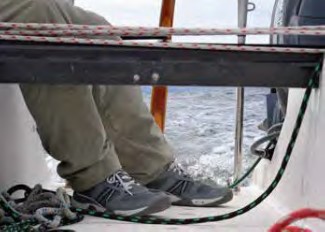
What to look for when buying your Dream Boat
In the nautical lexicon, it seems these three words – good old boats – always go together. Some of the most aesthetically pleasing designs from the boards of America’s greatest naval architects – Alden, Alberg, Gillmer, Herreshoff, Rhodes, Sparkman & Stephens and many others are now well along in age and, like old debutantes, in need of a face and structural lift.
When, in our wanderings, we find an older boat, a fiberglass boat which appeals to our hearts, our spirits soar, and a smile lights our faces and then fades. It fades when we consider the work and cost associated with the required plastic surgery. But need it fade?
Let’s assess our new love and evaluate the potential under the layers of grime.
The earliest fiberglass sailboats were built from designs originally intended for wood construction. The beam was narrow and the overhang long the waterline short and the interior small but the beauty is there.
A Herreshoff H-28 is still a Herreshoff, in wood or glass. A Hinckley Pilot is still a Stephens’ design, Seawind a Gillmer, Cape Dory an Alberg, Bounty a Rhodes, and a Pearson Countess an Alden.
Start with the basics
To evaluate our find, let’s start with the basics.
The earliest fiberglass hulls were thick and sturdy, approaching the originally designed wood thickness. The resins, until 1972, were of a formulation that resisted blistering. So the hull, barring physical damage, should be sound.
This is not necessarily so with the decks and cabinhouse. Take off your shoes and walk on every horizontal surface; dig your toes in as you walk. If there is a soft spot or delamination, you’ll feel or hear it. A crackling sound or a soft feeling will tell you of a problem. Don’t panic. Make a note of the location and keep looking.
If the boat is out of the water, next check the underwater gear. The older hulls – Triton, Ariel, Reliant – all had wood rudders with bronze shafts and strapping. Age, electrolysis, and marine life may have eaten holes in the wood or bronze. It can be fixed. Keep going.
Check mast, rigging, sails
The mast and rigging are next. The spars were usually wood or heavy-walled aluminum. Unless rotted, the wood can be reglued and the aluminum painted. The problem with the rig will be the standing rigging.
Most standing rigging will be stranded stainless steel wire with swaged fittings. There is no reliable way to evaluate the condition of rigging wire until it starts to break. To check for breaks, put on leather gloves and wipe all wire rigging with a paper towel. The paper will catch on the broken strands (called “fish hooks” for a good reason) and flag the break. This sure beats using your ungloved hand and marking the break in blood.
If you can’t be sure the wire is in good condition and has been replaced within the last 10 years, plan on replacing all standing rigging. Check each swage fitting by cleaning with metal polish and using a magnifying glass. Check for cracks or corrosion.
Just one fitting failure can bring your rig down. The cheapest way to replace standing rigging is with new wire and swages. The more expensive alternative is to use new wire and reusable fittings. Consult your budget and make notes.
Running rigging, sails, and all canvaswork can be evaluated visually. Raise all sails and check their shape. Are they baggy or stretched, do they set poorly under wind pressure? Try the poke test. Ask the owner for permission to hold a small section of the sailcloth in one hand and see if you can push your finger through it. If it gives, or if you make a hole, the cloth is deteriorated. This is probably due to ultra-violet rays from long exposure in use or just from being uncovered on the boom.
Sails will last a long time if properly cared for. They can be re-cut for better shape a whole lot cheaper than they can be replaced. Used sails can be bought from any number of sail brokers or lofts. Sometimes new sails are available at 50 percent of the original cost, if they were ordered and not picked up. Check your budget and your intended use. I’m not a racing sailor, so my old sails are fine for cruising use. The added speed from new sails is not worth the cost for me.
What about woodwork?
With one exception, the ondeck woodwork can be replaced or sanded down and refinished. The 37-year-old teak on my Ariel is still serviceable. The former owners never cleaned it, so they did not wear away the soft wood between the grain as happens when harsh chemicals and hard scrubbing are used to clean the wood.
The exception on deck wood is teak decks. The usual method of fastening teak to a fiberglass deck is to screw the teak directly to the fiberglass below. The teak is 3/8 to 1/2 inch thick and more of a veneer for looks than for a structural deck. The soft wood between the grain is worn away by the elements, people’s feet, washing, gear dropping on the deck, and other impacts. Over time, the deck gets so thin that the bungs covering the fasteners fall out, and the fasteners begin to work loose.
If the decks are very worn, and the bungs covering the screws are popping off, you will most likely find delamination underneath and a very large job ahead. Think about whether you’re willing to tear it all up and fill all those holes or just take a chance. Either way, it will be expensive in the long run.
Let’s go below
Open up all the hatches, cupboards, and drawers. Use a flashlight and a fine ice pick. Poke any discolored areas for rot. Check the area where bulkheads are bonded to the hull. Has the fiberglass tape pulled away from the wood? Has the mast step sunk into the keel? How about the keelbolts? Most, but not all of the earlier fiberglass boats, had encapsulated ballast. Some had lead or iron exterior keels. Check the bolts for corrosion. They will all look rusty, but determine if they have lost material. Are the nuts octagonal or rounded off? Hit the nuts gently with a small metal hammer. If you get a clear “ring,” they are salvageable. A dull sound means deterioration. Check the “floors” or supporting beam around the keelbolts. Are they discolored or soft? That fix is expensive.
Operate all the seacocks. They should open and close and be a nice bronze color. Yellow is brass. Pink/purple is bronze from which electrolysis has leached the zinc. In either case – yellow or pink – replace them.
Shine a light at as much of the hull-to-deck joint as you can to check the seam. See if there are any signs of leaks. Did water get in around the bolted fittings? Look for water stains. Investigate all deck hardware from underneath. Is it adequately bolted with a backing plate? A wood or fiberglass plate is nice, an aluminum plate is better, and a large stainless steel plate is tops. Carbon steel is OK, but it must be coated to resist rust. Carbon steel was seldom used in fiberglass yachts.
Check ports and hatches for operation and leaks. The aluminum port light on my Ariel fell apart in my hand when I tried to fix a leak.
Evaluate the systems
Finally, check the electrical, mechanical, and piping systems. The electrical system may need breakers to replace old fuses or new wire and/or fixtures. Are the running lights legal? The rules have changed over time.
The engine is a whole subject unto itself. If it runs, it is a plus. If it does not, a replacement may cost more than the boat is worth. Price replacement engines before making a decision.
Check the shaft and Cutless bearing for wear. If it moves up and down, replace the bearing. This is a big job, but not an expensive one, with the boat out of water.
An old Atomic 4 can be rebuilt and serve for years. These engines are simple and can be made reliable with upgrading. You are safe if care was taken to keep the fuel system in tight shape and you use your nose to check the bilge before each start. Blowers are required, but the nose is infallible. Diesel engines are really nice, but they’re expensive as a new or replacement system.
Check all tanks. Fuel tanks can leak and be almost unremovable. Water tanks, if fiberglass, can encourage the growth of various things and cause the water to taste terrible. Tanks can be cleaned out and repaired, but it is a labor-intensive job. As an example, you may have to remove the engine to replace the fuel tank or remove the cabin sole or V-berth to replace the water tank. Unless you are independently wealthy, you really don’t want to ask a boatyard to do the work.
Take a final look all around. I hope you’ve been taking lots of notes. Find a quiet place to review your findings and decide if the boat of your dreams can become your Dream Boat.
Common-sense boat buying
As a young adult with a wife and one child, I wanted a sailboat in the worst way. As with everyone at that stage of life, money was a problem. But I took my last $1,500 and made an offer on a used wood catboat “subject to survey.”
I’d owned boats all my life and had actually built several. Still, I was not trusting in my own abilities and felt I was doing “the prudent thing” in engaging a professional marine surveyor to protect my investment.
The surveyor inspected the boat, noted nothing wrong except, “the cockpit flooring will probably leak, ought to cover it with plywood,” and picked up his fee. Blinded by the “professional report,” I bought the boat.
It was only on a hard beat in the middle of Long Beach Sound that the knots began to fall out of the “knotty pine” wood planking. Using the anchor rope to plug up the holes, I was able to reach shore with my wife and young daughter.
I never could find the surveyor to ask him about the problem. It was probably just as well, as I had visions of sending him to sea in the very same vessel he had pronounced “seaworthy.”
The moral of the story? I ignored my own capabilities and common-sense judgments in favor of a “professional opinion.” If I would have taken the trouble to carefully inspect the hull myself, I would have seen the knotty planking, rejected the boat and been saved from a potentially life-threatening situation.
Any person who wants to buy a boat must like the water, have seen other boats, and have a good idea what type of boat is best for him. If a person takes his abilities to think, talk, observe, and reason and couples those abilities with common sense, that person can assess a boat’s condition on his own.
Basic common-sense questions should be considered: Is the boat clean? Does it look good? Does it do what it should do? For example, does the engine start easily and run well? Do the sails look good without wear? Do they raise and lower smoothly? Finally, is the owner/broker being honest? We all can sense when we are being conned or “sold a bill of goods.”
Three old cliches come to mind. “Handsome is as handsome does.” “If it looks right, it probably is right.” And, finally, “Buyer beware.” All three can be applied to any boat and will go a long way to assure the prospective buyer a successful purchase.
Having said all of the above, does this mean that a person should not hire a marine surveyor? Certainly not! Once a prospective buyer has applied his own common sense to inspect the vessel in question and decided in favor of the boat, then a surveyor should be called in to apply his detailed knowledge of marine design and construction to assess specific details about the boat.
As a person employs an accountant to do his taxes, a doctor to tend to his ills, and a mechanic to repair his car; a surveyor should be hired to assess and value the potential purchase. But only after the buyer’s common sense tells him or her, “It’s just what I want and in the condition I want it.”
A surveyor provides verification of the judgment already arrived at by the purchaser and simply points out the more technical points that need attention and are beyond the purchaser’s own knowledge.
In selecting a surveyor, use common sense, ask for references, ask to see reports on previous surveys, and, finally, don’t abdicate your responsibility in favor of the surveyor. Use common sense.
Article from Good Old Boat magazine, August/September 1998.





